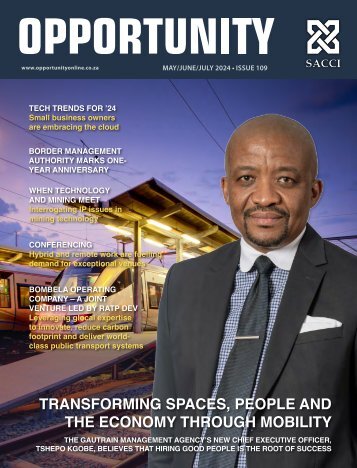South African Business 2016 edition
- Text
- Investment
- Government
- Business
- Development
- Network
- Sectors
- Investing
- Business
- Africa
- African
- Economic
- Manufacturing
- Mining
- Opportunities
- Economy
- Overview
OVERVIEW Events and
OVERVIEW Events and conferences Bookings in the years to 2017 promise an injection of R1.6-billion. South Africa has more than 1 000 events and conference venues ranging from wine farms and bush lodges to huge halls and exhibition centres. The meetings, incentive, conference and exhibition (MICE) sector is well equipped to grow. The three biggest centres for conferences, exhibitions and events are Johannesburg, Cape Town and Durban, with each city having invested heavily in large venues. But many resorts and game reserves have facilities for conferences, and smaller towns are attractive to some conference planners. KwaZulu-Natal has a good reputation for hosting major events, conferences and exhibitions, and is set host the 22nd edition of the Commonwealth Games. Durban 2022 will host all 71 member territories from the Commonwealth of Nations. The provincial capital is the focus of the sector, but all of the province’s big towns have good facilities and the Garden Route and several wine routes are well suited to a combination of business and pleasure. The Cape Town International Convention Centre (CTICC) plans to double in size, a R4.5-billion project that will create 8 000 jobs annually by 2018. Johannesburg Tourism Company has a dedicated unit, the Johannesburg Convention Bureau (JCB), which works to attract new business to the city. The JCB assists companies in preparing bid documents and is on hand to assist in supplying relevant information in key areas such as telecommunications and IT services and the securing of visas for delegates. The Sandton Convention Centre is surrounded by a range of hotels and is well located for delegates who want to shop in their free time. Eskom’s Megawatt Park Conference Centre and the Absa Convention Centre in Tshwane are some of the larger venues outside Johannesburg. In the Ekurhuleni metropole, the Airport Grand Hotel and Conference Centre is particularly well situated in relation to the main airport. Two of the region’s biggest venues are in the centrally located town of Midrand: Gallagher Estate and Kyalami Events and Exhibition Venue. A premier venue in Pretoria is the CSIR International Convention Centre. A new addition to the Pretoria skyline is the OR Tambo Building, a conference centre designed specifically to cater for the needs of South Africa’s National Department of International Relations and Cooperation. Regular meetings of the African Union and South African National Development Community (SADC) will be held in the R1.2-billion building, which also houses 2 500 departmental officials. SOUTH AFRICAN BUSINESS 2016 116
Trade with Africa Improved infrastructure will boost intra-African trade. OVERVIEW South Africa aims to diversify its economy away from an over-reliance on the primary sector (mining and agriculture) towards a more varied economy in which increased capacity in existing manufacturing sectors is coupled to the growth of wholly new areas such as alternative energy, biofuels and digital television. Trade policies and anti-competitive legislation are being aligned with the imperatives of industrial policy, ensuring that tariff agreements with trading partners do not undercut strategic targets. South Africa, with an annual total trade volume of R2.3- trillion, benefits from preferential trade agreements with the US and EU and its membership of the Southern Africa Development Community (SADC). The acceptance of South Africa into the BRICS group of nations (Brazil, Russian, India, China, South Africa) holds great potential for increased exports. Iron ore and coal are among the biggest export items to India and China, while the EU and US are strong markets for agricultural products like fruit. In the seven years before the global economic meltdown of 2008, sub-Saharan exports to the US grew to -billion, four times more than at the beginning of that period (AT Kearney). A key factor in intra-African trade is the development of improved infrastructure. The establishment of regional corridors is intended to boost this trade, with the North-South Corridor the most significant for the Southern African region as it runs through 26 countries and ends in Durban. Ten corridors are being developed to ease trading and improve access to ports. More than half of South Africa’s trade is with other countries in Africa, but the cost of trade in terms of tariffs, permits and delays at border posts can be very high. Shoprite spends about R200 000 a week in permits to keep its shops supplied throughout the continent. The South African Revenue Service (SARS) has initiated an automated custom system that is reducing costs and improving efficiency. It has been introduced at the Port of Durban, the country’s busiest port. 117 SOUTH AFRICAN BUSINESS 2016
- Page 1:
SOUTH AFRICAN BUSINESS 2016 EDITION
- Page 6:
CONTENTS Introduction CONTENTS Sout
- Page 10 and 11:
CREDITS Publisher Chris Whales Publ
- Page 12 and 13:
SPECIAL FEATURE South Africa A peri
- Page 14 and 15:
SPECIAL FEATURE In a year that saw
- Page 16 and 17:
SPECIAL FEATURE owes its existence
- Page 18 and 19:
SPECIAL FEATURE against water losse
- Page 20 and 21:
SPECIAL FEATURE Operation Phakisa h
- Page 22 and 23:
SPECIAL FEATURE late in 2014. The h
- Page 24 and 25:
SPECIAL FEATURE Understanding Afric
- Page 26 and 27:
INTERVIEW Job creation on track Ala
- Page 28 and 29:
SPECIAL FEATURE Business funding Th
- Page 30 and 31:
SPECIAL FEATURE in turn makes it ve
- Page 32 and 33:
SPECIAL FEATURE Contact: 012 394 18
- Page 34 and 35:
SPECIAL FEATURE Black Business Supp
- Page 36 and 37:
SPECIAL FEATURE The evolution of sk
- Page 38:
SPECIAL FEATURE providing TVET lear
- Page 42:
PROFILE FP&M Seta Facilitating and
- Page 45 and 46:
• The development of a national s
- Page 48 and 49:
FOCUS Champions of change Five dyna
- Page 50 and 51:
SPECIAL FEATURE The top law firms S
- Page 52 and 53:
SPECIAL FEATURE Keeping the BRICS t
- Page 54 and 55:
SPECIAL FEATURE Keeping BEPS in che
- Page 56 and 57:
SPECIAL FEATURE IPAP in action In 2
- Page 58 and 59:
FOCUS THERE’S NO END TO THE BENEF
- Page 60 and 61:
INTERVIEW The riches of Africa awai
- Page 62 and 63:
INTERVIEW and it could actually be
- Page 64 and 65:
PROFILE ECIC exco profiles Profiles
- Page 66 and 67:
INTERVIEW The hub of Africa Tim Har
- Page 69 and 70: Key sectors Overview of the main ec
- Page 71 and 72: OVERVIEW from the subsistence farme
- Page 73 and 74: OVERVIEW South Africa produces abou
- Page 75 and 76: South Africa’s looming energy gap
- Page 77 and 78: How will these resources be develop
- Page 79 and 80: Vall exclusive economic zone limits
- Page 82 and 83: OVERVIEW NEED PIC Mining The South
- Page 84 and 85: OVERVIEW Mineral beneficiation The
- Page 86 and 87: PROFILE The Council for Geoscience
- Page 88 and 89: OVERVIEW Energy The South African e
- Page 90 and 91: INTERVIEW Cummins South Africa Cumm
- Page 92 and 93: OVERVIEW Manufacturing Increasing m
- Page 94 and 95: OVERVIEW Automotive International i
- Page 96 and 97: OVERVIEW Automotive components Incu
- Page 98 and 99: OVERVIEW Chemicals and pharmaceutic
- Page 100 and 101: OVERVIEW Healthcare South Africa’
- Page 102 and 103: OVERVIEW Water Severe water restric
- Page 104: OVERVIEW Improving quality The intr
- Page 107 and 108: Our Vision is is “Quality water f
- Page 109 and 110: OVERVIEW 107 SOUTH AFRICAN BUSINESS
- Page 111 and 112: OVERVIEW airports in India and Braz
- Page 113 and 114: affords, while maintaining its envi
- Page 115 and 116: kets, except Australia. In Africa,
- Page 117: Rosebank, Johannesburg, renamed ‘
- Page 121 and 122: FOCUS MTN plugs R1.2-billion into K
- Page 123 and 124: MTN rolls out fibre infrastructure
- Page 125 and 126: OVERVIEW community engagement. The
- Page 127 and 128: PROFILE For BEE Verification and is
- Page 129 and 130: OVERVIEW attracting and retaining c
- Page 131 and 132: OVERVIEW Small business is taken ve
- Page 133 and 134: Franchise Fund—an innovative plat
- Page 135 and 136: educating young people in fields th
- Page 137 and 138: OVERVIEW Management Plan has divert
- Page 139 and 140: hazardous waste is also not being c
- Page 141 and 142: INTERVIEW yourself up as a Tier 1 o
- Page 144 and 145: OVERVIEW Renewable energy South Afr
- Page 146 and 147: INTERVIEW Plenty of scope for solar
- Page 148 and 149: LISTINGS South African business org
- Page 150 and 151: LISTINGS South African National Gov
- Page 152 and 153: LISTINGS Department of Communicatio
- Page 154 and 155: LISTINGS Department of Human Settle
- Page 156 and 157: LISTINGS Department of Science and
- Page 158 and 159: OVERVIEW Regional overview: Eastern
- Page 162 and 163: INTERVIEW Buffalo City on the rise
- Page 164 and 165: OVERVIEW Regional overview: Free St
- Page 166 and 167: OVERVIEW Regional overview: Gauteng
- Page 168 and 169:
FOCUS A Catalyst for Economic Devel
- Page 170 and 171:
FOCUS business people and tourists
- Page 172 and 173:
OVERVIEW Regional overview: KwaZulu
- Page 174 and 175:
OVERVIEW Regional overview: Limpopo
- Page 176 and 177:
OVERVIEW Regional overview: Mpumala
- Page 178 and 179:
The powerhouse of Africa Mpumalanga
- Page 180 and 181:
Mpumalanga: Key Sectors Mpumalanga
- Page 182 and 183:
Nkomazi Special Economic Zone The N
- Page 184 and 185:
INVEST IN THE PROVINCE OF THE RISIN
- Page 186 and 187:
OVERVIEW Regional overview: Norther
- Page 188 and 189:
OVERVIEW Regional overview: North W
- Page 190 and 191:
OVERVIEW Regional overview: Western
- Page 192 and 193:
FOCUS Khayelitsha - the power of to
- Page 194 and 195:
INDEX INDEX Abeco Tanks ...........
- Page 196:
ENSafrica.com ENSafrica | Africa’
Inappropriate
Loading...
Mail this publication
Loading...
Embed
Loading...























































































































































